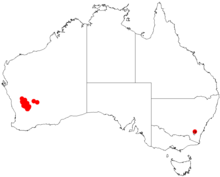| Acacia obtecta | |
|---|---|
| Scientific classification | |
| Kingdom: | Plantae |
| Clade: | Tracheophytes |
| Clade: | Angiosperms |
| Clade: | Eudicots |
| Clade: | Rosids |
| Order: | Fabales |
| Family: | Fabaceae |
| Subfamily: | Caesalpinioideae |
| Clade: | Mimosoid clade |
| Genus: | Acacia |
| Species: | A. obtecta
|
| Binomial name | |
| Acacia obtecta | |

| |
| Occurrence data from AVH | |
Acacia obtecta is a shrub of the genus Acacia and the subgenus Plurinerves that is endemic to a small area in south western Australia.
Description[edit]
The bushy shrub typically grows to a height of 1.5 to 3 metres (5 to 10 ft) and can have a rounded[1] or obconic habit with slightly ribbed, glabrous, pale grey branchlets. Like most species of Acacia it has phyllodes rather than true leaves. The glabrous and evergreen, patent to ascending phyllodes have a linear to oblanceolate and can be straight to shallowly incurved. the phyllodes are 7 to 10 cm (2.8 to 3.9 in) in length and 4 to 6 mm (0.16 to 0.24 in) in width and have curved and pointed tip and three distant, slightly raised nerves on each face.[2] It blooms from August to October and produces yellow flowers.[1] The simple inflorescences appear singly or in groups of up to four and have spherical flower-heads with a diameter of about 5 mm (0.20 in) containing 20 to 36 golden coloured flowers. Following flowering chartaceous seed pods form that resemble a string of beads. The glabrous pods have a length up to around 14 cm (5.5 in) and a width of 7 to 9 mm (0.28 to 0.35 in). The dull mottled brown seeds inside have a broadly elliptic shape and a length of 6 to 7.5 mm (0.24 to 0.30 in).[2]
Taxonomy[edit]
The species was first formally described by the botanists Joseph Maiden and William Blakely in 1927 as a part of the work Descriptions of fifty new species and six varieties of western and northern Australian Acacias, and notes on four other species as published in the Journal of the Royal Society of Western Australia. It was reclassified as Racosperma obtectum by Leslie Pedley in 2003 then transferred back to genus Acacia in 2006.[3] The shrub is most closely related to Acacia speckii and also resembles Acacia heteroclita, and is superficially similar in appearance to Acacia websteri which belongs to subgenus Juliflorae.[2]
Distribution[edit]
It is native to an area in the Wheatbelt and Goldfields-Esperance regions of Western Australia where it is commonly found on flat areas growing in sandy loam or clay or loamy soils.[1] The range of the shrub is limited to an area between Paynes Find in the north to Wubin in the south to around Kununoppin in the east with a population also found around Lake Barlee.[2]
See also[edit]
References[edit]
- ^ a b c "Acacia obtecta". FloraBase. Western Australian Government Department of Biodiversity, Conservation and Attractions.
- ^ a b c d "Acacia obtecta". World Wide Wattle. Western Australian Herbarium. Retrieved 22 December 2020.
- ^ "Acacia obtecta Maiden & Blakely". Atlas of Living Australia. Global Biodiversity Information Facility.